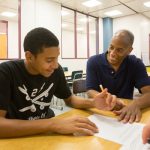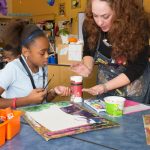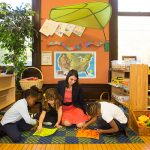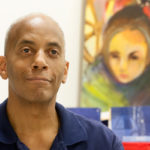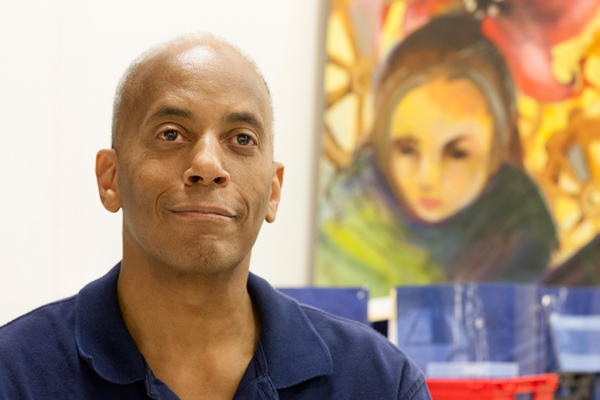
Eureka moments: stories from great teachers
A+ Schools share eureka moments that make teachers great
If great teachers are made — by their education and experience, by their instincts and talents — what were the moments when they figured things out? And what were the moments when they doubted they could move on and be a teacher at all — but got past them anyway? How do they know when their kids are learning? And what advice would they put on blackboards across America?
Stories from great teachers
We found seven great local teachers — chosen by principals, parents, colleagues and A+ Schools — and asked them each to tell us about some of their formative moments, and some of the ideas they can lend to up-and-coming teachers.
Was there one moment early in your career where you thought, I may not be able to do this?
I taught [English] in Mexico City, in a large, comprehensive K-12 school. English was required. English was a pathway into the world economy. I was a bit shocked when I came back to the United States and realized that not every child was interested in learning Spanish! In addition, I felt overwhelmed by administrative requirements, discipline, and the frenzied pace of the American school day. However, my sister, who had been working in Pittsburgh Public Schools for several years, told me, “Just remember, when you close that classroom door, it’s you and them. Do what you know is best for them.” She helped me to see past all of the clerical and additional constraints put on teachers today and to remember that the reason I chose to teach is the students.
— Colleen M. Pilarski, Pittsburgh Phillips K-5
I wish it were just one moment and then you noticed that you’ve arrived. For me, it’s almost daily. I’m continually caught up in What do my students need and how do I get that across to them? This year, my students and I are on a journey where we are learning two things in parallel: Algebra 2 concepts, such as representing and manipulating numbers in exponential form and, perhaps more importantly, how do we create a learning community that enables us to learn at the highest possible levels? This is daunting, and what helps to get me through it is to imagine that the classroom scenario is unfolding much like a scene in movie. In this moment, I ask myself, What should happen next for these learners to move them along in learning? In my mind, I allow myself to see possibilities: outrageous, creative, mundane, whatever it takes, and I imagine that the camera is rolling and this enables me to try and make good things happen for my learners — things that might not inherently be a part of me but are necessary for my learners.
— David Hairston, Pittsburgh Brashear High School
During my first year teaching, I had several students in my classroom who were reading and writing at a pre-kindergarten level. Helping those students to grow at incredibly rapid rates, in order to bring them to grade-level, was one of the hardest challenges I’ve ever encountered. They also had behavioral concerns that affected their academic achievement even more. Rather than turning away, I felt that those students were a test to me as an educator, especially a new one. For these students, the personal desire to experience educational success was not formed until they felt as though someone else cared about their achievement. I found myself spending every waking moment researching methods to help these students experience success, until I finally realized that they just needed someone to be their cheerleader. From that situation, I learned to voice to my students that I will always be their biggest cheerleader in the world, as long as they give me a reason to cheer.
— Jackie Davis, Urban Pathways K-5 College Charter School
In the beginning of my teaching career, I had to realize that there’s only so much that I can control. I had to learn early on that there are some things that happen in my students’ lives that are out of my hands. It’s upsetting and something that I still have a hard time dealing with, but I realize that I can still be a support system for my students and be there for them when they need me.
— Tiffany Hess, Kerr Elementary School, Fox Chapel School District
The toughest spot for me was when I was doing my student teaching. You’re just learning to teach and you’re trying to think what to do next and trying to think what you’re going to say next, because you’re not too good at thinking on your feet yet.
— Jennifer Porter, The Environmental Charter School at Frick Park
My first experience with my own kindergarten classroom was a rough assignment. When I heard that I would be taking over for a teacher who had died over the holiday break, I definitely thought, I don’t know if I can do this. I went in over the break and … transformed the classroom environment to get a fresh start. I braced myself for the students’ first day and … they really responded to me. I did not try to do things the way the old teacher had; I knew I had to take the reins and do things in the way I was comfortable. I brought puppets and storytelling and art into the classroom. My confidence grew with these favorite tools at my fingertips. When I arrived in January, two students in the class could read. By June, 32 of them could read. The lesson I learned is that … you have to be authentic to have success with children.
— Alison K. Babusci, Propel East
It was my first year of teaching. There were two third-grade classrooms and the other third-grade teacher was the Instructional Team Leader who retired in the middle of the school year. So I didn’t have another third-grade teacher to talk to or a team leader to go to. It was very overwhelming. Fortunately, another two teachers in the building helped me a lot and kept me there and gave me support. But at one point I really contemplated quitting. I told my husband, I don’t think this is what I’m supposed to be doing.
— Janice Motley, Pittsburgh Faison K-5
Was there one moment where you thought, Aha — I have something important figured out that will help me teach?
I think my biggest Aha moment is when I realized that teaching to the median was only going to really help the kids clumped around the median. Even though differentiation is sometimes an overwhelming task, doing my best to reach each child’s needs is really the only way to move every student forward.
— Colleen M. Pilarski
During the past few years I’ve made a tangible shift in my thinking about teaching. I used to think of schools as a place where learners came to get molded into the right shape in order to become successful later on in life. That approach can feel comforting from the perspective that you are treating all students the same way, and hence fairly, [but it] is flawed. The reality for me now is that students have a wide range of needs and it is the responsibility of the school to mold itself to meet the needs of each learner in such a way that gives each learner a real chance at being successful — otherwise it’s not really a school.
— David Hairston
Moving into my second year of teaching, I realized the extreme importance of modeling for students. During my first year, I would teach a concept, often expecting students to catch on and complete a task without providing many models along the way, fearing that they would simply copy the model that was provided for them. [Today] I have a student who couldn’t write two complete sentences on the first day of school. By helping her with modeling, setting academic goals, and staying conscious of her efforts, her weekly writing assignment amounted to three content rich paragraphs this week.
— Jackie Davis
The thing that has been the biggest motivator for me is when kids come in and say, ‘I was looking up all this stuff about bats and even my mom was looking up all this stuff about bats because we were learning about bats!’ That’s the moment when I really feel successful as a teacher.
— Jennifer Porter
In my second year, I had become the math specialist. Two little boys who happened to be cousins rode the same bus. They had been fighting on the bus. The principal called me into his office. These two little boys from the Hill District [were] fighting because they disagreed about the math we had done the day before. If you have two little boys fighting about math, you know you have sparked their desire. That’s when I knew I was going to stick this out.
— Janice Motley
What did your teacher certification program leave out that you wish it had taught?
I wished I had delved more deeply into literacy and math instruction. Being certified in elementary, you get a smattering of everything, but deep content is left unexplored.
— Colleen M. Pilarski
Some things you just have to experience before you can get a handle on them. I would put new teachers in a “bubble” that would allow them to grow their practice, safely over a span of 3-5 years and not expect them to be ready on day one.
— David Hairston
We become the mother or father to so many students when their own are absent, a photographer to capture all of the magical moments and yearly growth, the confidante that wipes away their falling tears, the cheerleader in the bleachers when no one else can make it, and even a comedian to ensure that they receive their daily dose of laughter. There are just some things that can’t be taught.
— Jackie Davis
Creativity and innovation. All of this stuff that I do, the hallmark of how I teach now and how I plan lessons, is figuring out activities and songs, thinking up ways to dramatize things or play games — that’s what I had to figure out for myself.
— Jennifer Porter
I was surprised that there were not more scholarly, contemporary ideas about classroom management and dealing with behavioral issues. The other thing that surprised me is that art education programs don’t actually teach art teachers how to physically manage all the materials and tools! It is a trick that once you learn it – it changes everything.
— Alison K. Babusci
Student teaching [should take place] before the senior year. There was a guy who came to our building to student teach — he was absolutely horrible. But they didn’t fail him. That’s how we end up with horrible teachers in the classroom.
— Janice Motley
When you’ve had a great class, what do your students do that confirms to you, Yes, this lesson worked.
They start to talk to each other, they start to take ownership of their learning, they ask questions, they want to know more, they are physically excited, amazed, curious, angry, sad. You know they are engaged because external stimuli that normally distract them are ignored. They are so involved in the learning that they don’t want it to stop.
— Colleen M. Pilarski
Another key is whether or not I walk away from the lesson having to wrestle with new knowledge myself. One particular lesson from a couple of years ago still has me looking for a unifying theme that ties together various geometrical patterns that my students uncovered. Last year, a student wondered why equilateral triangles (3 sides) and squares (4 sides) were considered “special” and regular pentagons (5 sides) weren’t. That lesson went well and I’m still wondering what’s not so special about regular pentagons.
— David Hairston
I read the story “Martin’s Big Words” to help explain the importance of empathic listening and self-control in challenging situations. On Thursday morning, one of my students walked in with tears in his eyes and began to explain … the hurtful things another student had said to him. He ended by saying, “Miss Davis, I remembered what we learned about Martin Luther King and, even though [the other child] hurt my heart, I just used my words and not my fists to tell him that his choices weren’t okay.” That, more than anything, shows me that what I do is making a difference in the lives of my students, both personally and academically.
— Jackie Davis
The truth is, you sometimes don’t know right away if a lesson worked. That is one of the great things about being the art teacher: you teach the same kids year after year and you really get to see that maturation and that meaning making as they grow.
— Alison K. Babusci
Have you discovered a particularly new, different or creative way of teaching one lesson or one subject that you can pass on to new teachers?
Word parts, word origins, how words relate to Spanish, where phrases come from that we use without thinking, how words can change by adding suffixes: kids get really into that. Kids have great minds and can make connections that we sometimes think they aren’t capable of making. When a child grows his/her vocabulary, it positively affects many other areas of learning.
— Colleen M. Pilarski
The importance of a “feeling check-in” cannot be overlooked. Typically, I start my lessons by asking a question similar to “How’s it going?” or “Is there anything happening today that we should know about because it might get in the way of our learning?” I’m amazed at the things that go on in the lives of my students and I’m impressed that many of them persevere through those things. If I can help, so be it.
— David Hairston
In math, I try to play a lot of different games, especially taking some ideas from various game shows, and I play the host. My students love the excitement that the game brings and they are learning Math concepts at the same time.
— Tiffany Hess
I’ve had a lot of success with teaching students to sew. Students love the immediate gratification of it and they don’t worry about the stitches being perfect; they are just so excited they made something on their own. I have found ways to simplify it for the youngest students, working with large needles, yarn and burlap for 1st grade and making it more interesting for the oldest students by doing untraditional sewing and combining it with interesting materials. I think art teachers shouldn’t forget about craft.
— Alison K. Babusci
I try to take each year as the first year. What I did last year doesn’t really matter, because these are a whole new group of kids.
— Janice Motley
Is there one intangible quality that you think a great teacher needs?
Love. A great teacher finds the good in every child. A great teacher … wants every child to feel what it feels like to fall in love with learning.
— Colleen M. Pilarski
Inner faith. You have to believe that all your learners can be great in their way.
— David Hairston
Compassion and empathic listening skills.
— Jackie Davis
A sense of humor! Having fun and bringing some life into your lessons keeps students engaged. Realistically, is every lesson going to be full of fun? No. Can students laugh and have a good time learning? Absolutely!
— Tiffany Hess
If you could leave one sentence of advice for budding teachers on every chalk- and whiteboard in America, what would it be?
“A small group of thoughtful people could change the world. Indeed, it’s the only thing that ever has.” Margaret Mead
— Colleen M. Pilarski
Effort creates ability.
— David Hairston
When you think about education, it’s imperative to be a “square peg” in a “round hole” kind of world, because those who are crazy enough to think they can make a difference in the lives of today’s youth are the ones that actually do.
— Jackie Davis
You may feel at times that you have failed, but in reality you have tried things that just don’t work — keep trying!
— Tiffany Hess
Think like your students.
— Jennifer Porter
Try yoga. Seriously, it’s so important for teachers to find a way to manage stress and stay healthy.
— Alison K. Babusci
Learn your students. Know them like you know your own kids and want for them what you want for yours.
— Janice Motley
About the teachers:
Colleen M. Pilarski teaches fifth-grade communications and is an Instructional Team Leader 2 in literacy at Pittsburgh Phillips K-5. She began teaching in 1992.
David Hairston teaches Algebra 2 to tenth graders at Pittsburgh Brashear High School. He began teaching in 1997.
Jackie Davis has been teaching second grade at Urban Pathways K-5 College Charter School since 2011.
Tiffany Hess teaches fourth and fifth grades at Kerr Elementary School in the Fox Chapel School District. She started teaching in 2007.
Jennifer Porter, a kindergarten teacher at The Environmental Charter School at Frick Park specializing in environmental literacy, began teaching in 2009.
Alison K. Babusci began her teaching career in 1992 and now teaches at Propel East.
Janice Motley has taught third grade, beginning in 2000, and most recently at Pittsburgh Faison K-5, where she is today a cohort manager, in partnership with Success Schools, supporting teacher efforts toward student discipline, rating and data collection.
Photographs by Larry Rippel.
From top to bottom: David Hairston, Alison Babusci, Colleen Pilarski, Jennifer Porter and David Hairston
